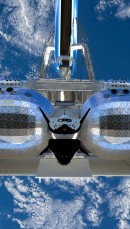At the time of writing, there is a single operating space station in orbit around Earth, namely the International Space Station. Well, make that one and a half, if we take into account the recently-launched, Chinese-made Tianhe.
But the number of orbiting, human-capable structures is likely to increase significantly over the next few years, their birth fueled by the success of the various companies that presently offer rides to the edge of space. The Russians will build their own habitat (probably) sometime soon, and a host of privately-owned businesses will do the same not long from now.
To be honest, private space structures are not something I personally took seriously until this week. I mean, yeah, people are willing to pay a fortune to reach space, but it’s one thing to go up and down in a matter of minutes, and another to spend several days in orbit, exposed to all sorts of dangers. Also, building something is space in not exactly an easy task.
I said I started taking things seriously this week because, after stumbling upon the Collins Aerospace announcement saying it was “awarded a $2.6 million contract by an undisclosed customer” to develop environmental control and life support systems for a “privately owned and operated orbital outpost,“ I realized that at least these guys, whoever they are, do mean business.
The unknown company needs from Collins systems to make the habitats livable, that comprise air revitalization, pressure control, cabin fans, heat exchangers, carbon dioxide removal, trace contaminant control, valves, regulators, and smoke detection. Also, “an active thermal control system to maintain optimal temperatures” must also be included in the package.
Collins does not say who the company paying for the contract is. At the moment, several such entities are eying a private space station for tourists, including Axiom, which describes itself as the world’s first commercial space station, and The Gateway Foundation, makers of the first space station with artificial gravity.
To be honest, private space structures are not something I personally took seriously until this week. I mean, yeah, people are willing to pay a fortune to reach space, but it’s one thing to go up and down in a matter of minutes, and another to spend several days in orbit, exposed to all sorts of dangers. Also, building something is space in not exactly an easy task.
I said I started taking things seriously this week because, after stumbling upon the Collins Aerospace announcement saying it was “awarded a $2.6 million contract by an undisclosed customer” to develop environmental control and life support systems for a “privately owned and operated orbital outpost,“ I realized that at least these guys, whoever they are, do mean business.
The unknown company needs from Collins systems to make the habitats livable, that comprise air revitalization, pressure control, cabin fans, heat exchangers, carbon dioxide removal, trace contaminant control, valves, regulators, and smoke detection. Also, “an active thermal control system to maintain optimal temperatures” must also be included in the package.
Collins does not say who the company paying for the contract is. At the moment, several such entities are eying a private space station for tourists, including Axiom, which describes itself as the world’s first commercial space station, and The Gateway Foundation, makers of the first space station with artificial gravity.











